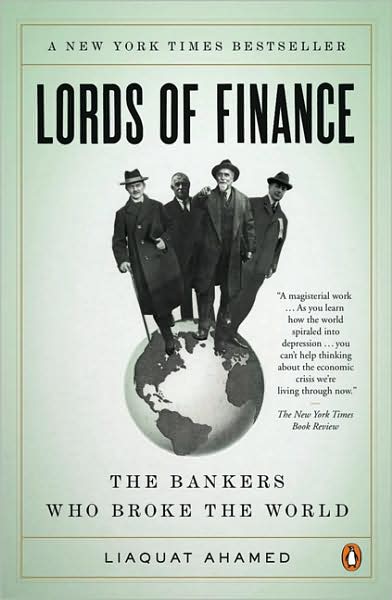Good reading: Lords of Finance: The Bankers Who Broke The World by Liaquat Ahamed (Penguin Press, 2009), 505 pp.
For investors tracking the ongoing efforts of governments and central banks to battle recessionary pressures and engineer a global economic recovery, we recommend strongly Ahamed’s informed and captivating Lords of Finance. The book focuses on the largely successful efforts of the central bankers of the U.S., England, France and Germany to restore economic and currency stability following the chaos of World War I and their subsequent policy mistakes that helped bring on the Great Depression. These bankers were men of sharply divergent backgrounds and personalities, and they were committed to the sometimes conflicting interests of their respective countries. Nevertheless, they managed at critical moments in the 1920s to coordinate policies, overcome the obstacles thrown in their path by the politicians, and weather one crisis after another. The glue that held them together was a near-religious faith in the gold standard, which they managed to restore after World War I and to maintain for a tumultuous decade. Ironically, the author argues that it was their slavish adherence to this inflexible gold standard that ultimately triggered the Depression and in the process tragically ruined their careers and reputations. For the author, who is no fan of the gold standard, the heroes of the book are John Maynard Keynes, the brilliant and controversial English critic of these central bankers, and Franklin Roosevelt, who rejected the insistent advice of his economic advisors and took the U.S. off the gold standard at the depths of the Depression in 1933.
Readers will enjoy and profit from Lords of Finance even if they are not sophisticated in economics or historians of the Great Depression. Ahamed, whose background includes a stint at the World Bank, patiently and expertly explains the formation of the Federal Reserve and its inner workings through the 1920s and 1930s. He also provides a clear explanation of the gold standard with its benefits and limitations, and places the economic and currency crises within a broader political and social historical context. Readers will also appreciate the ability of the author to paint personality portraits of the major protagonists. The book is a useful antidote to the currently fashionable thesis that seismic economic events, such as the Great Depression, are the consequence of largely impersonal and unavoidable political, social and demographic trends.
In a very instructive epilogue, Ahamed compares the Great Depression with the 2008-2009 global economic and financial crisis. Although he acknowledges the two events share many of the same characteristics, he concludes that the differences outweigh the similarities. His major point is that The Depression was the consequence of the misguided policies of politicians and central bankers; modern policy makers, enlightened by the errors of their predecessors, are now pursuing a contrary set of policies that will result in a more favorable conclusion.
The book deserves its accolade as the Financial Times and Goldman Sachs 2009 business book of the year.

